AACR ANNUAL MEETING 2017: ADOVCATING FOR THE CANCER RESEARCH AGENDA
On April 15, 1908—a year after founding the American Association for Cancer Research—the charter members of the AACR gathered at the New York State Cancer Laboratory (later renamed Roswell Park Cancer Institute) in Buffalo, New York, to discuss their most recent studies and observations related to the cancer problem. A total of 12 papers were presented at the one-day meeting, which was later designated as the first AACR Annual Meeting.
Since that auspicious beginning, the Annual Meeting has become the touchstone event for the entire cancer research community. The 2017 Annual Meeting hosted a record number of attendees for the fifth consecutive year, bringing together more than 21,800 scientists, clinicians, other health care professionals, survivors, patients, and advocates to Washington, D.C., to share the latest innovative cancer science. While the size and scope have increased dramatically since 1908, the mission of the Annual Meeting is the same—to foster the collaboration and communication that are critical to understanding, diagnosing, treating, and curing cancer.
Beau Biden Cancer Moonshot
In April 2016, then-Vice President Joe Biden addressed Annual Meeting attendees to discuss the launch of the National Cancer Moonshot Initiative. One year later, Mr. Biden returned to the AACR Annual Meeting to outline the progress made to date and to thank the attendees for their efforts to accelerate that progress. Noting that the initiative “had evolved from a program to a movement,” Mr. Biden reminded the attendees that “this is no time to stop the momentum.”
Following Mr. Biden’s remarks, leaders from government, academia, industry, patient advocacy organizations, and Capitol Hill participated in a panel discussion titled “Beau Biden Cancer Moonshot: Progress and Promise.” The panel addressed how the Beau Biden Cancer Moonshot provision that was included in the 21st Century Cures Act is stimulating the acceleration of progress against cancer and how it will result in better outcomes for patients.
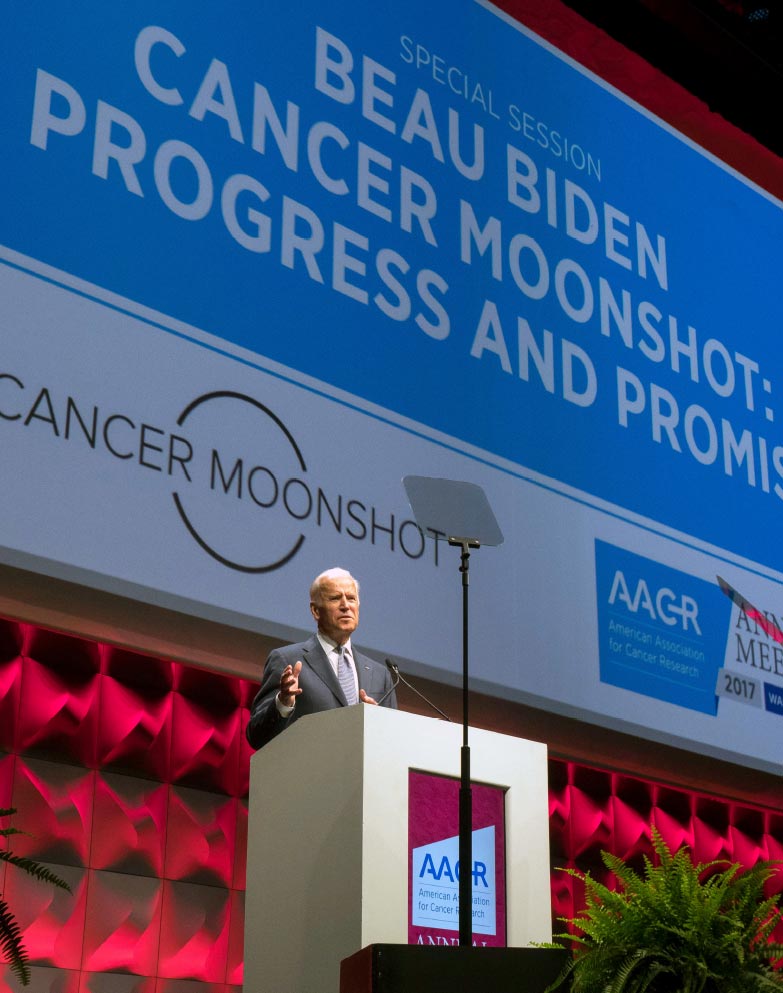
Taking a Stand for Sustained Cancer Research Funding
While Annual Meeting attendees gathered to acknowledge and accelerate the recent progress made against cancer, they also united against potential threats to that progress. In the weeks before the meeting, the Trump Administration proposed to reject the $2 billion increase considered for the National Institutes of Health’s 2017 budget while also releasing a 2018 budget that would cut an additional $5.8 billion from the NIH. During the opening ceremony, AACR President Nancy E. Davidson, MD, FAACR, presented a Distinguished Public Service Award to Senator Roy Blunt (R-MO), the chair of the Senate Appropriations Subcommittee on Labor, Health and Human Services, in recognition of his dedication to ensuring sustained funding for the NIH. The opening ceremony closed with more than 12,000 meeting attendees standing in unison to express their belief that continued progress against cancer depends on making NIH funding a national priority.

Bringing the Promise of Cancer Research to Washington
While providing a forum for leading scientists and clinicians to expand their expertise, the AACR also brought that expertise to the Washington, D.C., community through an educational event titled “Progress and Promise Against Cancer.” Moderated by 2017-2018 AACR President Michael Caligiuri, MD, the event convened thought leaders from academic and government institutions with patient advocates to discuss important topics such as cancer prevention and early detection, the latest advances in precision medicine and immunotherapy, and how the current policy landscape might affect cancer patients.
Annual Meeting Attendance by Year
1908
Attendance exceeds 10
1954
Attendance exceeds 500
1959
Attendance exceeds 1,000
1989
Attendance exceeds 5,000
1999
Attendance exceeds 10,000
2005
Attendance exceeds 15,000
2017
Attendance exceeds 20,000

Innovative Cancer Science
The theme of the AACR Annual Meeting 2017, Research Propelling Cancer Prevention and Cures, highlights the fact that all of the progress made to date with regard to the prevention, detection, and treatment cancer is based on research. The multidisciplinary program brought together researchers from across the spectrum of cancer research with the goal of continuing that progress. Highlights of the cutting-edge cancer science presented at the meeting were summarized by AACR leaders in a wrap-up plenary session.
During the closing plenary, Kornelia Polyak, MD, PhD, chair of the 2017 Annual Meeting Program Committee, discussed key basic science presentations with a focus on new insights in cancer biology that were obtained using advanced technologies. Some of these presentations outlined how new technologies can be used to study different molecular characteristics of single cancer cells in a tumor—such as genetic, RNA, and protein characteristics—while others focused on noninvasive detection and monitoring tumor responses to therapy using liquid biopsies and molecular imaging. Polyak also highlighted presentations using CRISPR-based technologies to advance understanding of cancer genomics, 4C-seq technology to enhance knowledge of epigenetic changes in cancer cells, and artificial intelligence to help pathologists make more accurate diagnoses.
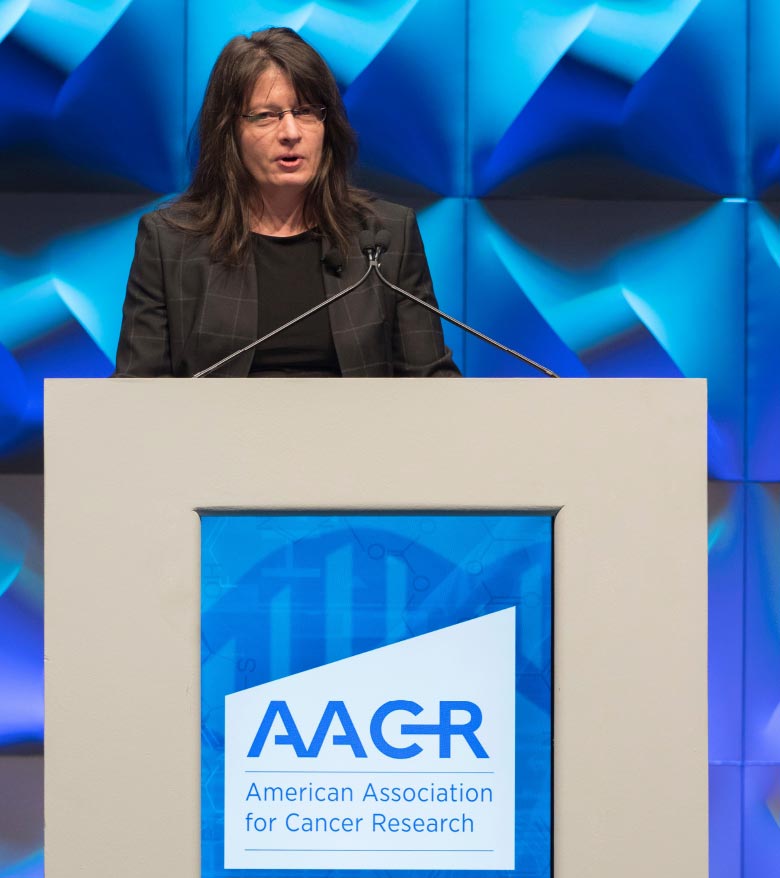
2017–2018 AACR President-Elect Elizabeth M. Jaffee, MD, provided an overview of some of the clinical trials presented at the meeting, focusing on three main areas. She opened by discussing several presentations on clinical trials using immunotherapies called checkpoint inhibitors. These included one trial showing that the five-year survival rate for lung cancer patients treated with nivolumab (Opdivo) was four times higher than the historical rate and several trials indicating that Merkel cell carcinoma and nasopharyngeal carcinoma respond to single-agent checkpoint inhibitor therapy. Jaffee then highlighted a second group of presentations showing the promise of other types of immunotherapy, including IDO inhibitors and CAR T cells, before closing by reviewing a number of trials about new ways to use two types of molecularly targeted therapies—HER2-targeted therapies and PARP inhibitors.
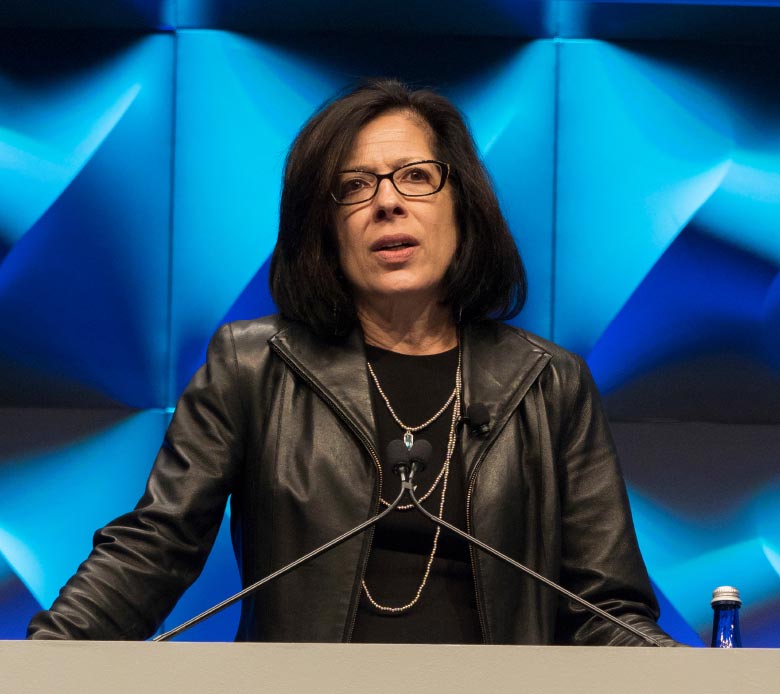
Nancy E. Davidson, MD, FAACR, AACR President 2016–2017, highlighted several areas of cancer prevention and early detection research discussed at the meeting. The first area was the proposal of a precancer genome atlas project similar to The Cancer Genome Atlas to better understand the biology of precancerous lesions and identify new ways to intervene and prevent cancer from developing. She then focused on new efforts to reduce tobacco use and rates of obesity, both of which are responsible for a substantial number of cancer cases. Among the presentations Davidson discussed was one that suggested that introducing individuals to smoking cessation programs at the time of lung cancer screening might help reduce lung cancer deaths. She then concentrated on several presentations about therapeutic approaches to cancer prevention, including one suggesting that daily low-dose aspirin use can reduce cancer mortality and several reporting new approaches to precision prevention. Davidson concluded her summary by emphasizing presentations in the field of cancer health disparities research. Several of these presentations showed that there is a huge need for increased representation of racial and ethnic minorities in cancer genomics research, indicating that much work remains to be done to address this daunting challenge.
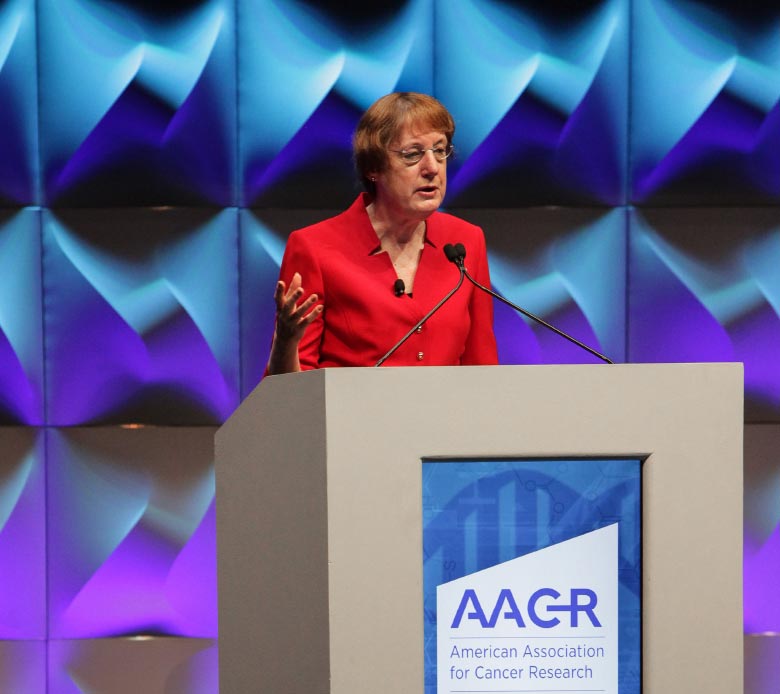
Michael A. Caligiuri, MD, AACR President 2017–2018, concluded the session by detailing areas of research he believes can drive immense progress against cancer in the future, such as enhancing efforts in cancer health disparities, harnessing the promise of big data, and educating the public about the importance of implementing our knowledge of lifestyle factors that can increase cancer risk. He also highlighted the importance of advocating for increased funding for cancer research and for developing initiatives to preserve the cancer research workforce in order to accelerate the pace of scientific and clinical progress.
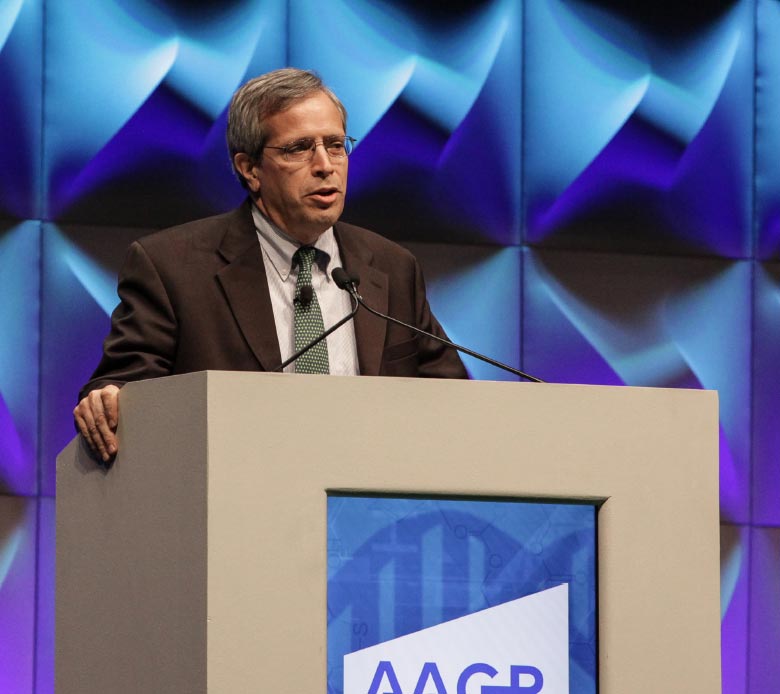
Annual Meeting
At A Glance
21,800
People attended the meeting. The Annual Meeting 2017 was the largest in the history of the AACR.
71
Countries were represented at the meeting.
6,396
Proffered papers were accepted for presentation in poster sessions or minisymposia.
60
Meet-the-Expert sessions were presented at the meeting. These single-speaker sessions featured leaders in all fields of cancer research discussing their areas of expertise. The experts participated in extended question-and-answer periods, giving early-career scientists vital opportunities to expand their understanding as well as their professional networks.
247
Scientific sessions highlighted the latest breakthroughs in basic, translational, and clinical cancer research—including 45 major symposia, five plenary sessions, and 32 educational sessions. While providing a forum for cutting-edge science, the Annual Meeting program also explored larger questions in the field. For example, in a special session titled “Are There New Hallmarks of Cancer?,” Douglas Hanahan and Robert A. Weinberg (right) updated their seminal work on carcinogenesis by proposing additional enabling characteristics that distinguish cancer cells from normal cells.
7,900
Annual Meeting attendees who registered to attend the AACR Cancer and Biomedical Research Career Fair. As a destination of choice for representatives of academic, industry, and government institutions focused on cancer research, the Annual Meeting provides scientists and physicians with a unique opportunity to build their professional networks and advance their careers.
141
Clinical trials were presented, the largest number of trials ever presented at an AACR Annual Meeting. Several high-impact trials were presented in special sessions, including two trials that received significant media coverage:
Data from a phase I trial demonstrated that treatment with the immune checkpoint inhibitor nivolumab (Opdivo) yielded durable responses in some patients with advanced non-small cell lung cancer (NSCLC). The five-year survival rate for NSCLC patients in the trial was 16 percent, as opposed to 5 percent for patients receiving standard-of-care treatment.
According to final results of a phase III trial, glioblastoma patients who wore a medical device that delivers alternating electrical fields in addition to being treated with the chemotherapeutic temozolomide had significantly improved median overall survival compared with those treated with temozolomide only. Adding the tumor-treating fields—which are thought to block cell division—to temozolomide increased the two-year survival rate to 43 percent, as compared to 27 percent for temozolomide alone.
13
Sessions organized by AACR Working Groups, including town halls, networking events, and scientific sessions. As part of their mission to foster collaboration around focused areas of cancer research, the Working Groups organize these sessions to create communities of interest within the broader scope of the Annual Meeting.

Media Coverage
The AACR Annual Meeting 2017 generated global interest, as the innovative cancer science presented in Washington produced a significant amount of news coverage and social media activity.
17
News releases were distributed.
200
Reporters registered to cover the meeting.
2,165
Media mentions were generated.
10,900
People viewed Snapchat posts that used the Annual Meeting geofilter graphic. With the launch of its account in Washington, the AACR became the first cancer research organization to use Snapchat at its Annual Meeting. In addition to offering a conference geofilter and posting candid photos from the meeting, the AACR partnered with member and social media advocate Emil Lou, MD, PhD, to interview winners of the Annual Meeting Undergraduate Poster Competition using the organization’s Snapchat account.
34,212
Tweets mentioned the #AACR17 hashtag.
45,862
People viewed the AACR’s Facebook Live broadcasts during the Annual Meeting. The AACR conducted four live broadcasts during the meeting, including a discussion of important science presented at the meeting. 2017-2018 AACR President Michael A. Caligiuri, MD, moderated the discussion, which featured Annual Meeting Program Chair Kornelia Polyak, MD, PhD, as well as press conference moderators Suzanne Topalian, MD, and Louis M. Weiner, MD.

7,928
Unique users joined the Annual Meeting conversation on Twitter.
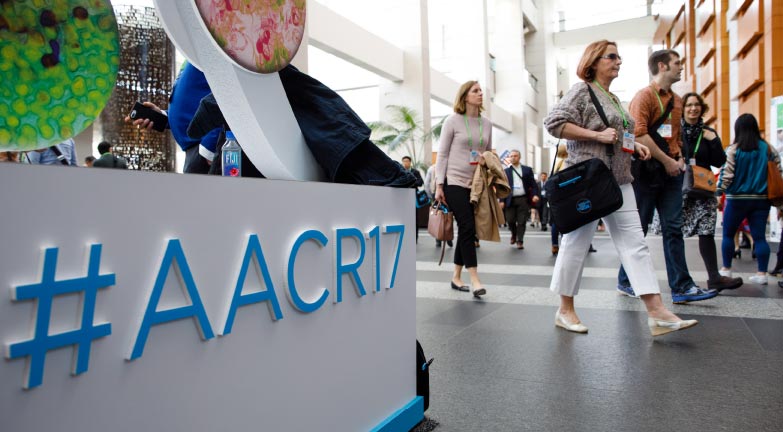
Among the many news organizations covering the Annual Meeting were the following major media outlets:







